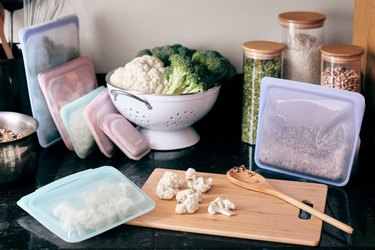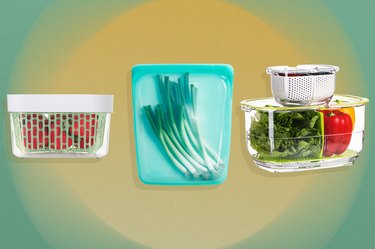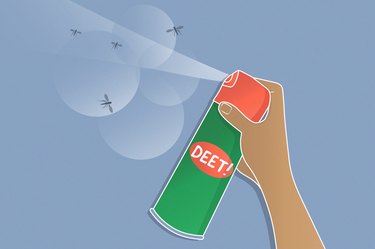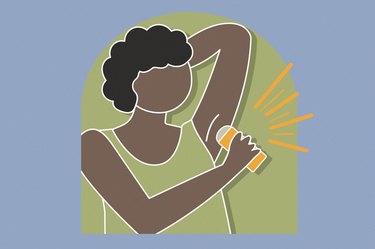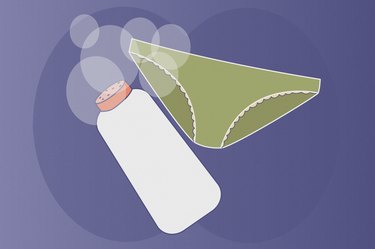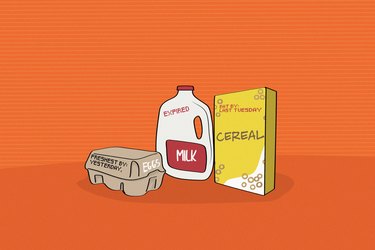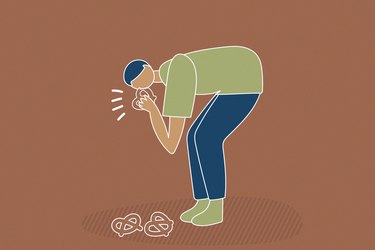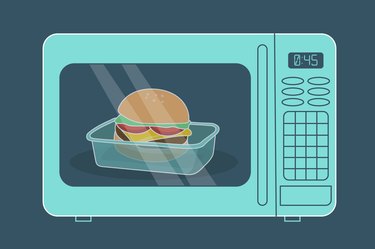
Plastic containers are a convenient way to store food. And hey, who among us hasn't tossed a Tupperware of cold pizza into the microwave for a quick zap? But while the habit is commonplace, heating plastic may not be so good for our health.
The short of it is this: Although you can put plastic in the microwave, these containers are made of chemicals that can potentially be harmful to your wellbeing.
Video of the Day
Video of the Day
We spoke to Kelly Johnson-Arbor, MD, medical toxicology physician and co-medical director at the National Capital Poison Center, to get the low-down on whether you can microwave plastic (plus safer ways to reheat last night's leftovers).
Chemical Leaching
So, can you put plastic in the microwave? Well, sure — at one point or another, most of us have. But just because you can doesn't mean you should.
That's because a microwave's high temperatures can cause chemicals to leach out of plastic, according to the National Institute of Environmental Health Sciences (NIEHS).
One of the most common offenders is a chemical called bisphenol A (BPA), which is a regular component of plastic food containers, water bottles and personal care products, per the NIEHS. As plastics break down in the microwave, the chemical can leach into your food and, as a result, your body, Dr. Johnson-Arbor says.
BPA isn't the only chemical of concern: Phthalates — which gives plastic containers their flexibility and durability — can also leach into food, per the Washington State Department of Health.
Exposure to phthalates has been shown to affect animals' reproductive systems, according to the Centers for Disease Control and Prevention. However, it's not yet clear how this chemical affects human health specifically.
Tip
Chemical leaching doesn't just happen in the microwave — it can also occur if plastic is heated in any way or gets damaged (think: scratches or wrinkles), according to the National Poison Control Center. That's why reusing plastic water bottles is not recommended.
Potential Health Effects of Chemical Leaching
Too much exposure to chemicals in plastic — particularly BPA — has been linked to certain health problems. BPA specifically is primarily connected to health issues in children, according to the Columbia Center for Children's Environmental Health.
Still, it's wise to skip microwaving plastic regardless of your age to avoid these potential complications:
1. Hormone Disruption
"Some bisphenol compounds can act within the human body as endocrine disruptors, which means that they can potentially affect fertility, puberty and even cancer development," Dr. Johnson-Arbor says.
For example, BPA can mimic hormones like estrogen, which can lead to changes in cell behavior that have been linked to cancer development and progression, according to January 2015 research in Medicine.
2. Learning, Behavior and Mood Disorders
According to the Columbia Center for Children's Environmental Health, exposure to BPA can put kids at increased risk for developing certain learning, behavioral and mood disorders because their brains are still developing.
These conditions may include:
- Learning and behavior disorders like ADHD
- Anxiety
- Depression
3. Other Diseases
Per the Columbia Center for Children's Environmental Health, BPA exposure has also been linked to conditions including:
- Type 2 diabetes
- Obesity
- Heart disease
Tip
If you must use a plastic food container or another plastic vessel (like a water bottle), make sure it's labeled "BPA-free" to avoid possible health issues, according to the Columbia Center for Children's Environmental Health.
Doctor-Recommended Alternatives
Indeed, even though plastic can technically go in the microwave, it's best to use a different food container. In lieu of plastic portables, try these expert-recommended alternatives instead:
1. Glass Containers
Dr. Johnson-Arbor recommends the use of glass or ceramic containers. That's because glass is made to withstand high microwave temperatures without breaking and has a non-porous surface that doesn't allow liquid or other fluids to flow through it.
2. Paper Plates
Not all non-reusable plates can be microwaved, which is why paper plates are often a safer choice, Dr. Johnson-Arbor says.
Just beware of paper plates that have a plastic coating, as those are not microwave-safe, she says.
3. Stainless Steel Containers
While stainless steel containers cannot be microwaved, they are a safer choice if you're looking to store your food before or after it hits the microwave.
"Eco-friendly containers that do not have a plastic or chemical coating are also safe alternatives," Dr. Johnson-Arbor says.
So, How Bad Is It Really to Microwave Plastic?
While it's common practice to microwave plastic, it's best to avoid the habit due to the potentially dangerous effects of leaching chemicals.
Instead, Dr. Johnson-Arbor recommends using glass containers because they're made to withstand microwave heat and prevent leaching. Ceramic and paper plates (without plastic coating) are another great alternative.
But if you can't avoid microwaving plastic, at least take Dr. Johnson-Arbor's advice: "If you use plastic containers, make sure they are microwave-safe," she says. This means picking BPA-free containers that won't melt or warp under heat.
- National Institute of Environmental Health Sciences: "Bisphenol A (BPA)"
- Washington State Department of Health: "BPA and Phthalates: Chemicals found in our homes"
- Centers for Disease Control and Prevention: "Phthalates Factsheet"
- Medicine: "Bisphenol A and Hormone-Associated Cancers: Current Progress and Perspectives"
- Columbia Center for Children's Environmental Health: "Bisphenol-A (BPA)/Bisfenol A (el BPA)"
- National Poison Control Center: "BPA and the Controversy about Plastic Food Containers"
Is this an emergency? If you are experiencing serious medical symptoms, please see the National Library of Medicine’s list of signs you need emergency medical attention or call 911.

